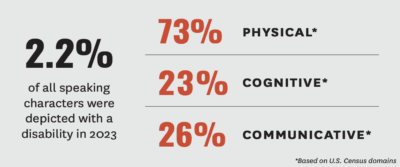A new report shows that films continue to lack disabled characters. The USC Annenberg Inclusion Initiative report, “Inequality in 1,700 Popular Films,” found that just 2.2% of all speaking characters in the top 100 films of 2023 were shown with a disability, which is virtually identical to both 2022 (1.9%) and 2015 (2.4%). According to the report, “each year, the numbers prove stubbornly resistant to change.”
Furthermore, of the top 100 films of 2023, 42 films did not feature even one character with a disability. This is lower than 2022 (54) but similar to 2015 (45). Only one out of the 100 films examined portrayed disabled characters at proportional representation within the U.S. population (27.2%). The only other year to include a film with proportional representation since 2015 was in 2021.
The USC Annenberg Inclusion Initiative began tracking disabled characters in 2015.
Characters were most likely shown to have one or more physical disabilities (73%). The study included a variety of disabilities in this category including those who use a mobility device, were missing limbs, had a facial difference, were Little People, or had various chronic health conditions including asthmas, sickle cell anemia, and diabetes. 26% of disabled characters had communicative disabilities including those relating to sight, hearing, or speech. An additional 23% had cognitive disabilities including mental health conditions, dementia, Down syndrome, and traumatic brain injuries.
Only 8 of the top 100 films depicted a lead or co-lead with a disability. This is significantly lower than 2022 (14 films) but not meaningfully different from 2015 (10 films). Most disabled characters were either supporting (54%) or inconsequential to the plot (35%).
Disability Is Intersectional
This lack of overall progress for disabled characters is unfortunately in line with the lack of representation across the board, including girls and women on screen. Fewer girls and women filled leading roles in 2023 compared to 2022—the figure plummeted to 30%, on par with 2010 and a 14-percentage point decline from the year prior.
The report states that the portrayal of characters with disabilities also “reflects a lack of imagination on behalf of storytellers.” When looking at the intersection of identities, most characters with disabilities were male-identified (72%) and more than half (55%) were White. None of the disabled characters were part of the LGBTQ+ community.
“Stories thus reflect a portrait of this community that ignored younger, female identifies, underrepresented, and LGBTQ+ identified people,” the report states. “Given the longstanding stigma and biases surrounding disability, stories do little to offer a different perspective on people with living with disabilities and instead perpetuate a narrative of invisibility and homogeneity.”
Disabled Children Need to See Themselves Represented
Nearly half of disabled characters represented in the top 100 films are 40 years of age or older. Only 9% of disabled characters were teenagers and just 6% were children.
With kids and teens spending on average between 4-9 hours a day watching or using screens, according to the American Academy of Child and Adolescent Psychiatry, the stories shown on those screens and who is in them matter.
A report from Common Sense Media on “Why Representation Matters for Kids’ Ethnic-Racial Development” found that authentic racial representation shapes kids understanding of their own racial identities, as well as their understanding of others’ racial identities. This understanding affects how kids treat others of different racial backgrounds than their own. Authentic disability representation can have the same effect on kids as authentic portrayals of people of color. It is imperative to include disabled kids and teens in film and TV to portray the reality that disability affects people of all ages and backgrounds.
Looking Toward the Future: Disability Behind the Camera
The Annenberg study did not report on behind-the-camera disabled talent, such as writers, producers, and directors. This is likely because many studios and production companies do not track this information. Also of note, the missing information in the Annenberg study regarding disabled talent behind-the-camera reflects gaps in inclusive and accessible work environments, and hiring processes that create barriers for disabled writers, producers, and directors.
The report calls for several strategic solutions to foster systemic change, noting that what has “worked” in the past was “exclusionary, discriminatory, and catered to the whims of a majority audience that no longer exists.” In addition to setting target inclusion goals and company-wide inclusion policies, the report calls for supporting nonprofit organizations training new filmmakers.
Disability Belongs™ aims not only to shed light on the lack of representation of the disability community in film and television, but also to address it head-on through talent pipeline programs and studio consulting services. “Increasing the number of disabled characters on camera starts with hiring disabled talent behind the camera,” said Lauren Appelbaum, Senior Vice President of Entertainment and News Media of Disability Belongs™. “That’s one of the reasons we founded our annual Entertainment Lab for disabled writers, producers, directors, and other behind-the-camera entertainment professionals. We connect studios to our Lab alumni and broader network of disabled talent so they can be hired in all aspects of the storytelling process.”
By not including disabled characters, films are losing out on an important audience. “With the disability community accounting for $8 trillion in annual disposable income, including authentic disability representation in film and TV isn’t just the right thing to do, it’s business savvy,” added Lawon Exum, Entertainment and News Media Director of Disability Belongs™.







